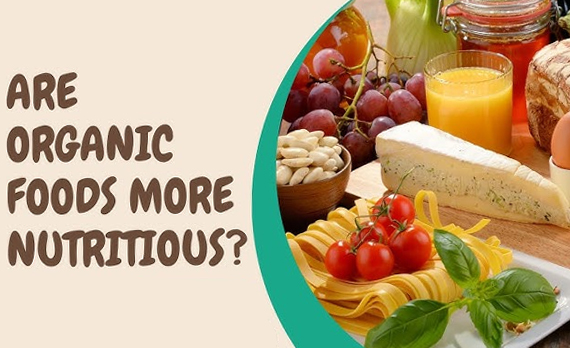Is organic food healthier?
Is organic food healthier? Organic foods continue to increase in popularity across the U. S. with many believing eating organic is better for health. About 5% of total food sales are organic, and that is projected to increase by an average of 6% each year.
However, is it really true that organic is healthier? The idea of organic food is a great concept, but it can also burn a hole in your wallet.
What does it mean for food to be organic?
The U.S. Department of Agriculture defines organic as crops that are produced on farms that have not used most synthetic pesticides herbicides or fertilizer for three years before harvesting the food. There needs to be a significant buffer zone to decrease contamination from adjacent farm lands. Farms also have to be free from any genetic engineering, ionizing radiation or sewage sludge (yuck). And as it relates to livestock, animals must be fed organic feed, live on organic land and be raised without routine antibiotics or hormones.
Free range doesn’t mean organic; it just means animals weren’t kept in such small enclosures. Also, the “natural” label on food means there’s no artificial flavoring or color ingredients, but that doesn’t mean it’s organic or free of pesticides.
Why are organic foods often so much more expensive than conventionally grown produce and meat?
On average, organic foods are priced about 50% higher than their conventionally produced equivalents. This is primarily due to the meticulous farming practices required. Pests, weeds, and diseases must be managed using physical, mechanical, and biological methods instead of chemical pesticides. In the case of meat and dairy, non-organic animals are often administered growth hormones to boost milk production and steroids to enhance growth, resulting in greater yields. This increased production allows farmers to charge less since they have more product to sell.
Is organic food more nutritious than regular food?
Organic foods are not healthier, per se, in terms of nutrients. You are still getting the same benefits in conventionally grown foods as you are in organic foods.
What is organic milk? Is organic milk healthier than regular milk?
Organic milk has the same protein, mineral, lipid and vitamin content as normal milk. Nonorganic milk typically has growth hormones, which are specific to each species. So, drinking milk with bovine growth hormone, which is degraded by stomach acid, has no physiological impact on humans.
Is it safe to buy nonorganic meat?
Sex steroids, such as estrogen, may be administered to cattle to enhance meat production, increasing efficiency for farmers. However, the levels of these steroids are very low, with treated and untreated cattle showing similar amounts. When combined with other sex steroids, some individuals might be at risk of adverse effects.
Antibiotics can also be used to boost growth in livestock. While they are similar to those prescribed for humans, they are not intended for treating health problems. This practice contributes to the rise of drug-resistant bacteria, which can be transmitted to humans, complicating infection treatment.
What effects can pesticides have on children? Can they have effects on adults?
Increased exposure to pesticides is associated with a higher risk of ADHD and autism. It may also contribute to diminished cognitive abilities, learning difficulties, and memory problems. Additionally, pesticide exposure has been linked to the development of Parkinson’s disease, fertility issues, and cognitive decline later in life. There is also a potential connection between cancer and pesticides; in 2015, the International Agency for Research on Cancer classified three widely used pesticides as carcinogenic, with dietary sources being the main route of human exposure.
Overall, is it better to eat organic?
Organic diets are known to result in lower exposure to pesticides and antibiotics, but nutritionally, they are largely comparable to conventional options. Additionally, there is no evidence of significant clinical differences between organic and conventional milk. While no definitive studies prove that organic foods lead to healthier children, choosing organic can be beneficial, given the potential links between pesticide exposure and neurodevelopmental issues, as well as its strong associations with cancer.
Should you buy all organic produce? Or are there some fruits and vegetables that are OK to buy nonorganic?

Avocados, cantaloupe, pineapple, broccoli, cabbage and corn have low levels of pesticides, so there’s no real need to buy organic. In contrast, strawberries, spinach, grapes, apples, tomatoes and celery have high levels of pesticide residues. If you want to get the most bang for your buck on produce, frozen veggies can be cheaper than fresh, and they are very similar in quality.
It’s often a split-second decision.
You’re in the produce aisle, and those organic apples on display look nice. You like the idea of organic — but they’re a few bucks extra. Ditto for the organic milk and meat. Do you splurge? Or do you ask yourself: What am I really getting from organic?
Scientists have been trying to answer this question. And the results of a huge new meta-analysis published this week in the British Journal of Nutrition adds to the evidence that organic production can boost key nutrients in foods.
The study finds that organic dairy and meat contain about 50 percent more omega-3 fatty acids. The increase is the result of animals foraging on grasses rich in omega-3s, which then end up in dairy and meats. The findings are based on data pooled from more than 200 studies, and research in the U.S. has pointed to similar benefits.
“Omega-3s are associated with reductions in cardiovascular disease, enhanced neurological development and function, and improved immune response,” says study co-author Chris Seal, a professor of food and human nutrition at Newcastle University in the U.K. “We believe it’s essential for nutrition,” Seal explained. However, organic meat and dairy products have significantly lower levels of omega-3s compared to fish like salmon.
These findings contribute to an expanding body of evidence showing how farming practices can affect the nutritional profile of foods.
Another extensive meta-analysis published in 2014 in the British Journal of Nutrition found that organic crops — including carrots, broccoli, apples, and blueberries — contain significantly higher amounts of various antioxidants and other potentially beneficial compounds. This review analyzed data from over 300 studies.
For example, organic crops had about 50 percent more anthocyanins and flavonols than conventional crops. Anthocyanins are compounds responsible for the blue, purple, and red colors of fruits and vegetables like blueberries.
The consumption of these compounds is linked to numerous health benefits, including anti-inflammatory properties. Flavonol compounds, commonly found in fruits and vegetables, have also been shown to protect cells from damage, which can help prevent disease.
Organic crops often face higher levels of stress, such as insect attacks, according to Seal. In response, they produce compounds to help combat these challenges.
For instance, when a carrot fly lands on a carrot and begins to feed, the plant has limited options.
In conventional farming, a pesticide can be applied to deter the pest. However, in organic agriculture, the carrot must rely on its own defenses. As Seal explains, the carrot produces polyacetylenes, which have a bitter taste that discourages the fly.
These polyacetylene compounds may not only repel pests but could also provide health benefits for us. Research in animals suggests that these compounds may help reduce inflammation and lower cancer risk, but it remains unclear how much needs to be consumed to positively impact human health.
Current studies are working to clarify this, but the complexity of our diets and the way our bodies absorb nutrients make it challenging to isolate the benefits of specific micronutrients.
Another key difference between organic and conventional crops is how they obtain nitrogen. Conventional crops receive consistent doses of nitrogen through synthetic fertilizers, whereas organic systems rely heavily on crop rotation and composting, resulting in generally lower nitrogen availability.
Consequently, organic crops tend to grow more slowly and produce higher levels of secondary plant metabolites. These compounds may also have health-promoting properties when consumed.
A study conducted at the University of California, Davis, in 2008 found that organic tomatoes had nearly double the concentration of a beneficial flavonoid called quercetin compared to conventional tomatoes grown in adjacent fields.
But if you like the environmental benefits of organic agriculture, these studies point to potential nutritional benefits as well, at least when it comes to maximizing the antioxidants and micronutrients you get from foods.


